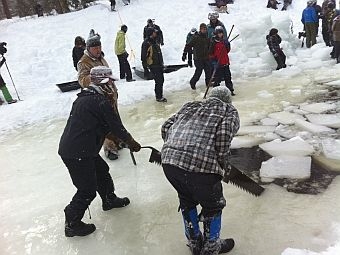 (Host) Summer may feel like it’s a long way off now. But at the Farm & Wilderness summer camps in Plymouth, they’re already gearing up.
(Host) Summer may feel like it’s a long way off now. But at the Farm & Wilderness summer camps in Plymouth, they’re already gearing up.
At one of the camps, which has no electricity or running water, getting ready for summer means filling an old-fashioned ice house. And that requires a lot of manpower.
So for the past 40 years, Farm & Wilderness has held an annual ice cutting weekend, where campers, counselors, alumni and their families converge on the remote hillside camp, Flying Cloud, to cut and haul blocks of ice from a pond to fill the ice house.
VPR’s Samantha Fields went to check it out.
(Fields) In the winter, the only way in to Flying Cloud is up a trail of deep, uneven snow. You have to keep your eyes on your boots – and every so often one of your legs sinks in up to your knee.
Still, Pieter Bohen, the executive director of Farm & Wilderness, estimates that nearly 300 people – from 5 year olds to 70-somethings – came out for this year’s ice cutting.
(Pieter Bohen) "Which is incredible when you consider the mile-plus hike that they took up here."
(Fields) And once you’re up there, it’s cold. And you’re sawing, cutting, lifting and hauling heavy blocks of ice for hours.
But for this crowd, that’s all part of the fun.
(Jennifer Freeman) "It’s a perfect winter vacation. I can’t think of anything I’d rather do than work in the snowy woods."
(Fields) Jennifer Freeman came up from Manhattan with her family. Both of her teenage sons spend the summer at Farm & Wilderness. This is their fifth ice cutting.
(Jennifer Freeman) "It’s an old fashioned thing. It’s natural, it’s connected to the land, and when they come back in the summer they can know it was something they did and they prepared for themselves, and months later it will keep their food cold."
(Fields) The pond they’re cutting the ice from is small – at 8 feet deep, it covers just about a quarter acre.
(Pieter) "We call it the puddle."
(Fields) In the summer, it’s where the campers swim. Now, dozens of people are spread across the ice wielding big, strange looking tools.
Antique ice saws with large metal teeth… long poles with hooks on the end, to coax floating ice close enough to the edge… and metal tongs big enough to grab hold of the square blocks and drag them ashore.
This is a real group effort. Just like it would have been back in the days before refrigeration, when ice houses were much more common.
(Jay Kullman) "Not a lot of this type of work exists anymore, and I think a lot of people are fascinated by it to some degree."
(Fields) That’s Jay Kullman. He’s the facilities director for the camps.
(Jay Kullman) "It’s one of our most popular events. And the community of it – everyone getting together and working hard. There’s not opportunity for that anymore."
(Fields) Charlotte Marcolla is a camper-turned-counselor. She says the camaraderie and hard work of the ice cutting weekend are quintessential Farm & Wilderness.
(Charlotte Marcolla) "Because at Farm & Wilderness we have a saying that work is love made visible. And this really kind of shows it. Working together, spending the day together, taking a weekend and just being here all together. It really just shows how much we love the place."
(Fields) The ice house is a good distance from the pond, up a gently sloping hill. From the outside, it just looks like a medium-sized wooden shed. They’ve rigged a pulley system to get the ice up from the pond. Black plastic sleds are attached to thick yellow rope that runs down the hill. A couple dozen people stand along the rope – and when they get the signal that a sled is ready to go, everyone grabs onto the rope… and runs.
After a minute or two of pulling hard, the sled slides into view. They do this over and over, with sled-full after sled-full of ice. Inside the ice house, another rowdy, organized group of volunteers is stacking ice, and shoveling saw dust between the blocks. The saw dust acts as insulation, and keeps the ice from melting, even once the weather turns hot and humid.
By mid-afternoon, the ice cutting is done, and the ice house is packed from floor to ceiling. Everyone gathers around, holding hands and forming a huge circle in front of the now-stocked ice house. It’s windy and snowing, like it has been all day.
("Circle up!" "Thank you, thank you, thank you!")
A day’s worth of hard work that will keep food cold and the camp functioning – without electricity – for the whole summer.
For VPR News, I’m Samantha Fields